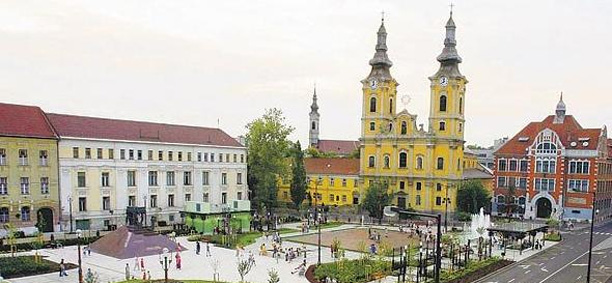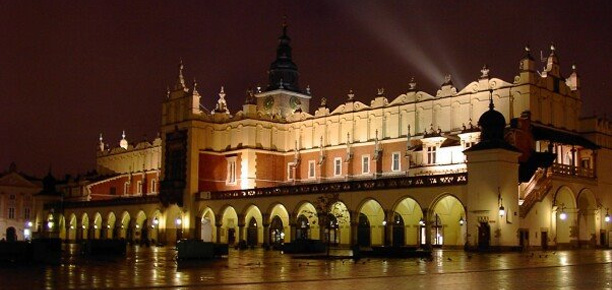Cities of Member Universities and Representatives
The history of universities is in many cases closely related to the history of cities in which the universities are based. The cities, which are usually highlights of the region, provide a clear evidence of mutually beneficial relationship between the city and a higher education institution. Universities and colleges add a special flavour to social, cultural and sport city life and their influence is also embedded in tangible and intangible assets of the cities (history, architecture, infrastructere etc.). In any case it is worth visiting those cities and, at least, to walk on the streets of their historic centers.
SLOVAKIA
Košice
Košice is a town with a rich and famous history. The first written reference dates back to the year 1230. Under a privilege granted in 1324, Košice became a free royal city. In 1369, Emperor Louis I the Great granted Košice a coat of arms, the first city in Europe to receive such a privilege. Throughout the whole of the 14th and 15th centuries Košice was an important name in long-distance trade and one of the largest and richest cities in the whole of Hungarian Kingdom. The historical centre represents the best preserved type of town with a lens-shaped square. From among a number of cultural monuments, the late Gothic Cathedral of St. Elizabeth should be mentioned in particular. It is a unique monument in European terms, and in Slovakia it ranks in the first place.
Nowadays, Košice with almost three hundred thousand inhabitants, the second largest city in Slovakia, is an important centre of population and industry, with recently beautifully renovated historic center.
For more look at http://www.kosice.sk/ or http://en.wikipedia.org/wiki/Košice.

For more look at http://www.trencin.sk/ or http://en.wikipedia.org/wiki/Trencin.
HUNGARY
Miskolc
For more look at http://www.miskolc.hu/pages/ or http://en.wikipedia.org/wiki/Miskolc.
POLAND
Warsaw
Warsaw is located in the heart of the North European plains on a well-drained terrace of the Vistula River. Warsaw was founded in 1280 by the dukes of Mazovia. They erected a castle so that they could control passage on the Vistula River; this marked the beginning of the development of Warsaw, which became the capital of the Duchy of Mazovia in 1344. In the 15th century, the Dukes established their residence in Warsaw. The city's political role became more important as its functions multiplied. In 1596, the seat of the King of Poland was transferred from Krakow to Warsaw. A period of prosperity and intense architectural activity followed. The city was destroyed by the Swedes and reconstructed twice, in 1656 and in 1702. At the end of the 18th century, it was one of the largest cities in Europe.
Following the Second World War, during which 85 per cent of Warsaw was destroyed by the Nazi troops, and the insurrection of August 1944, the reconstruction of the city was wilfully undertaken. By 1966, all of the monuments of the old city were re-erected according to their appearance between the 14th and 18th centuries. As the capital of Poland, Warsaw fulfils all the various functions involved in being the country’s main city, supported by its cultural and economic significance. Among the capitals of Europe Warsaw ranks seventh as to number of inhabitants and surface area. With more than one and a half million inhabitants in the city itself and another seven hundred and fifty thousand in the surrounding suburbs, Warsaw accounts for one sixth of Poland’s population.
For more look at http://www.um.warszawa.pl/en or http://en.wikipedia.org/wiki/Warsaw.

Cracow, the former capital of Poland and royal residence is one of the biggest European centres of culture and science. The historical area in Cracow with its original layout dating back to 1257 has survived to this day. Its Old Town is like a museum: full of treasures and old architecture. The monuments which deserve special attention include the Gothic Collegium Maius, now the Museum of the Jagiellonian University, the Main Market Square with the Cloth Hall (14th century) and St.Mary’s Church which contains the famous altar-piece, a gem of European Gothic art, carved in wood by Wit Stwosz. Cracow’s architecture and art collections offer a unique survey of cultural achievement from the early Middle Ages till today. Contemporary Cracow (with the population of about three quarters of a million) is not only a city of historical monuments and mementos. It is the country’s second biggest centre of science and education after Warsaw and an important centre of industry.
The University of Mining and Metallurgy (UM&M) was established in Cracow in 1919 and commenced its existence with only two Faculties (Faculty of Mining - 1919, Faculty of Metallurgy - 1920) that were the nucleus of the almost entire contemporary UM&M. Today, at the UM&M there are 14 Faculties, 1,800 university teachers and about 20,000 students (12,000 of them attend regular courses).
For more look at http://www.krakow.pl/english/ or http://en.wikipedia.org/wiki/Cracow.
Rzeszow, the largest town in the south-east of Poland, is picturesquely located on the River Wislok, bordered by the Sandomierska Valley in the north, the hills of the Carpathian Plateau and the Strzyzowsko-Dynowskie Plateau in the south. It is an important centre of international transport due to its geographical location (it is situated not very far from the national borders of Ukraine and Slovakia). Two major roads of international importance meet here: the E-40, which connects Ukraine, Moldova and the Caucasian States with Western Europe, and the route linking Belorus and the Baltic States (Lithuania, Latvia and Estonia), through the checkpoint in Barwinek, with Slovakia and other countries in Central and Southern Europe. Rzeszow has also got its own airport in Jasionka, about 6 km north of the town in the direct vicinity of the newly-built East West motorway. It has been adapted to suit the needs of continued international traffic. The traditions of education in Rzeszow go back to the beginning of the 15th century, since the historic records from 1406 mention teachers of the local parish school. At present time about 25,000 young people are being taught in 29 secondary schools in Rzeszow under the tutorship of almost 1,700 teachers. After the second World War Rzeszow achieved the position of an academic centre. There are eight various universities and other schools of higher education here: Rzeszow University of Technology, Pedagogical University, a branch of Maria Curie-Sklodowska University of Lublin, a branch of Krakow Academy of Music, Institute of Theology; and two public schools: Higher School of Management and Computer Science, Higher School Sociology and Economy. All the above schools and universities are attended by more than 30,000 students
For more look at http://www.rzeszow.pl/ or http://en.wikipedia.org/wiki/Rzeszow.
For more look at http://www.katowice.eu/en/ or http://en.wikipedia.org/wiki/Katowice.
UKRAINE
Lviv
Few cities in the world are like an open-air museum. One of them is Lviv - a great European city which is an original and inseparable part of the image of contemporary Ukraine. In the 10th century the territory of the present-day Lviv region was part of the ancient Kyivan state, at that time one of the most influential countries in Europe and the Middle East, a rival to Byzantium.
The city of Lviv was founded by Prince Danylo Halytsky, later king of Galicia-Volhynia between 1240 and 1250. Lviv, meaning "city of the Lion", was named in honour of Danylo's son Lev (i.e. Leo - the Lion). First historical records about Lviv are from 1245. Lviv was founded as a fortress for the defence of trade routes. However, it later lost its defensive significance and became a major commercial and economic centre. The favourable geographical location of the city at the cross-roads of important trade routes from western Europe to Asia and from Scandinavia to Byzantium led to a rapid expansion of trade and manufacture. Germans, Armenians, Greeks, Serbs, Jews, Poles, Hungarians, Italians and Tartars settled in Lviv.
The publication of the first printed book in Lviv, Ivan Fedorov's "Apostle", was the beginning of book publishing in Eastern Europe. Literature, architecture and fine art developed in Galicia. In 1661 the University of Lviv was founded. In 1844 a Technical Academy was founded in the city, later to be renamed to Lviv Polytechnic.
Lviv, which today has a population of over 830 000, is the cultural, political and economic centre of Western Ukraine. The economy of Lviv is strong, with the presence of leading industrial branches such as engineering, instrument manufacturing, chemistry, glass, ceramics and timber as well as printing and tourism. A network of specialised banking institutions is developing.
Today Lviv is a city of science and education. Eight institutes of the Ukrainian National Academy of Sciences are based here, and there are more than 40 scientific research, design and planning institutes, twelve higher education institutions with some 100,000 students. Visitors to Lviv are impressed by well-preserved architecture dating from the 17th to 20th centuries. The Lviv historical city centre is registered as a UNESCO world heritage site.
For more look at http://www.ct.lviv.ua/ or http://en.wikipedia.org/wiki/Lviv.
For more look at http://www.sbedif.if.ua/city/ or http://en.wikipedia.org/wiki/Ivano-Frankivsk.
For more look at http://www.uzhgorod.net.ua/ or http://en.wikipedia.org/wiki/Uzhgorod.
ROMANIA
Cluj-Napoca
The oldest settlements in the Cluj-Napoca area are more than 120,000 years old. They existed throughout the Stone Age, the Bronze Age and the first period of the Iron Ages. During the Dacian period, an important settlement was located within the Cluj-Napoca territory, and the Dacian name of Napoca was kept even during the Roman rule. The first Roman documentary notation of Cluj-Napoca town dates from 107 - 108 AD. Cluj-Napoca received the rank of Municipium and later of Colonia, becoming one of the major cities of the Roman Empire. The first Middle Age evidence of Cluj-Napoca dates from 1173. In 1213, the fortress of Cluj (Castrum Clus) is mentioned. The first guild - furriers' guild - dates from 1367. Until the 15th century, the number of guilds increased to over 30. The town became a thriving commercial and cultural centre, and in 1405 it was declared a free town. During the second half of the 16th century the town was known as "The Treasure City". After 1541, when Transylvania became an autonomous Principality, the political importance of Cluj increased. After the establishment of the Austrian rule - late 17th century - Cluj was declared several times capital of Transylvania. In 1920 the city, with the rest of Transylvania, was incorporated into Romania, and in the mid-1970s it was joined with neighbouring Napoca. Nowadays, Cluj-Napoca is Romania's second largest city and an important industrial, cultural and academic centre as well as a cross-road of communication with road, rail and air links.
For more look at http://clujnapoca.ro/en or http://en.wikipedia.org/wiki/Cluj-Napoca.
For more look at http://www.bucuresti.ro/ or http://en.wikipedia.org/wiki/Bucharest.
For more look at http://www.oradea.ro/ or http://en.wikipedia.org/wiki/Oradea.
For more look at http://www.aradon.ro/ or http://en.wikipedia.org/wiki/Arad,_Romania.
For more look at http://www.apulum.ro/index-en.htm or http://en.wikipedia.org/wiki/Alba_Iulia.
For more look at Petrosani - homepage or http://en.wikipedia.org/wiki/Petro%C8%99ani.
SERBIA
SuboticaFor more look at http://www.subotica.com/ or http://en.wikipedia.org/wiki/Subotica.







